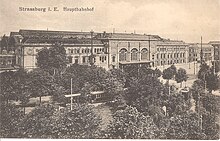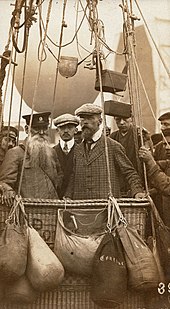Hermann Zimmermann
Hermann Zimmermann (born December 17, 1845 in Langensalza , † April 3, 1935 in Berlin ; full name: August Ernst Hermann Zimmermann ) was a German civil engineer and Prussian construction officer .
youth
Zimmermann was born on December 17, 1845 in the house at Herrenstrasse 9 in Langensalza, the son of a doctor. His family moved to Mühlhausen / Thuringia in 1852 , where he attended high school. After breaking off his high school career (Latin and Greek deterred him), he first considered joining the Prussian Navy in 1862 , instead he sailed on various merchant ships until 1868 and came to Africa and the East Indies . He completed his nautical training in Hamburg in 1867 with the acquisition of the first class helmsman's license with distinction . In 1868 he did his military service as a one-year volunteer in the Navy of the North German Confederation .
Education
In 1869, at the age of 24, Zimmermann changed his professional goals and began studying engineering at the Karlsruhe Polytechnic , where he was one of Franz Grashof's most talented students . Another teacher was Hermann Sternberg . His studies were interrupted by his participation as a soldier in the Franco-German War of 1870/71 . Since the Institutes of Technology in Germany is not the time for this promotion law possessed Zimmermann put his scientific work on contact kinematics in 1874 as a doctoral thesis at the University of Leipzig before and philosophy was there (Dr. phil.) To the doctor doctorate . Although Zimmermann had concentrated more on civil engineering in the course of his studies , he completed his studies in Karlsruhe in 1875 with an examination focused on engineering as a whole, which is therefore particularly difficult and only taken by a few students, for which he received a diploma from the university received.
Strasbourg (1875-1881)
On the recommendation of his university professor Hermann Sternberg (1825–1885), he was initially employed by the Imperial General Management of the Railways in Alsace-Lorraine in Strasbourg . In order to keep a career as a civil servant in the civil service open, Zimmermann made up his Abitur at the Strasbourg Lyceum in 1878 , which in turn was a formal prerequisite for the first state examination at the Karlsruhe University of Applied Sciences. He then worked in Strasbourg for a further three years, as a section builder in the construction of the new Strasbourg Central Station (1878–1881). In addition, he was involved in the construction of the rotating domes with clockwork drive for the Strasbourg observatory in 1878, which attracted the attention of the high-ranking Prussian construction officer Albert Kinel in Berlin.
Berlin (from 1881)
Presumably under the influence of Kinel, Hermann Zimmermann was appointed to the Reich Railway Office in Berlin in 1881 , initially he held the subordinate position of a permanent unskilled worker . During this time he wrote scientific works in which he dealt with the railway superstructure and with vibrations of girders with moving loads. Here, too, a constructive design that was created outside of his official activities received great attention, according to which in 1888 the large dome over the meeting room of the Reichstag building in Berlin could be built despite static problems. The architect of the Reichstag, Paul Wallot , had failed at the task before.
1891 Zimmermann was in the Prussian Ministry of Public Works appointed to Berlin, where he initially for secretly building officer and the presenting counsel was appointed. In 1895 he was promoted to the secret senior building officer and in 1905 to the real secret senior building officer . In 1891 he succeeded Johann Wilhelm Schwedler as the highest Prussian construction officer. Bridges and platform halls in the entire network of the Prussian State Railroad fell under Zimmermann's responsibility , he also advised on the construction of the Imperial Court building in Leipzig and proposed a construction for the dome of the New Town Hall in Hanover.
As early as 1891 the Prussian Academy of Civil Engineering appointed Zimmermann as an extraordinary member, in 1901 he became a full member. In 1904 he became a member of the Prussian Academy of Sciences , as the second engineer after Heinrich Müller-Breslau .
Despite being in good health and not being forced by the age limit for civil servants introduced in 1923 , he retired in 1911 - shortly after his 65th birthday - but continued to devote himself to various honorary positions.
His book on railway superstructure from 1888 served until the 1960s as a basis for calculating stresses in the track bed and railway sleepers and rails. From 1886 he dealt with the kink problem, one of his main areas of research. In 1901 he published his experience with space frameworks such as the Reichstag dome in a book on space frameworks.
Private
Hermann Zimmermann married his bride Clara Lambert († 1923) from Darmstadt in 1875 , with whom he had four children, including two sons. At the time of his 80th birthday, he had ten grandchildren. All that is known about these descendants is that the eldest son worked as a chemical engineer in Spain in the 1920s.
Zimmermann also dealt with the aviation industry off-duty , for his services in this field and his proven skills as a balloonist he was made an honorary member of the Berlin Aviation Association . He was well acquainted with Ferdinand von Zeppelin , whom he advised on the construction of airship hangars and accompanied on at least one flight.
Zimmermann found a sporting balance to his extensive official and voluntary activities in mountaineering , in 1905 he climbed Mont Blanc at the age of almost sixty , and even at the age of eighty-two he was still vigorous enough for a mountain tour in the Pyrenees. At a later age he first became involved with music, had a bass clarinet made according to his own ideas and soon played works by Haydn and other classics. At the end of his life he slowly went blind.
Awards
After the technical universities had received the right to doctorate and honorary doctorate in 1900, the Karlsruhe University awarded its renowned graduate Hermann Zimmermann an honorary doctorate as Dr.-Ing. Eh Among the numerous other honors and awards, the Grashof Memorial Coin , which was awarded only around 100 times from 1894 to today and named after his teacher in Karlsruhe, stands out, which he received in 1924 from the Association of German Engineers .
Fonts (selection)
- About the degree of safety of the building structure, especially the body subject to buckling. Centralblatt der Bauverwaltung, Volume 6, 1886, pp. 217–219, 225–227, 243–245.
- The relative movement of surfaces of revolution in contact. Journal for Mathematics and Physics, 19th year, Leipzig, 1874, pp. 242–258. (on-line)
- The calculation of the railway superstructure. Ernst & Son , 1888.
- The vibrations of a beam with a moving load. Ernst & Son, 1896
- About the earth pressure on retaining walls. Centralblatt der Bauverwaltung, Volume 16, 1896, pp. 150–153, 354.
- About spatial frameworks, new forms and calculation methods for domes and other roof structures. Ernst & Son, 1901.
- The three-dimensional framework of the dome of the Reichstag building. Zentralblatt der Bauverwaltung, Volume 21, 1901, pp. 201–203, 209–214.
- The doctrine of kinking on a new basis. Ernst & Son, 1930
- A little adventure in the Pyrenees. Reprinted from the communications of the Berlin Section of the Alpine Club, 1929
literature
- Saller: For Hermann Zimmermann's eightieth birthday. In: Zentralblatt der Bauverwaltung . Volume 45, No. 50, December 16, 1925, p. 606 f. ( online as PDF)
- Bohny: Mr. Wirkl. Secret senior building officer aD Dr. phil. Dr.-Ing. eh Hermann Zimmermann for his 80th birthday. In: Bauingenieur , 6th year, issue 37, December 18, 1925, pp. 1011-1013. ( online as PDF)
- K. Beyer: About the importance of Zimmermann as a researcher. In: The civil engineer. 6th year, issue 37, December 18, 1925, pp. 1013-1015. ( online as PDF)
- Schaper: On the eightieth birthday of Hermann Zimmermann. In: Bautechnik , Volume 3, Issue 55, December 18, 1925, p. 775. ( online as PDF)
- Kulka: Hermann Zimmermann on his eighty-fifth birthday. In: The civil engineer. 11th volume, issue 51, December 19, 1930, p. 881. ( online ) (as PDF)
- Karl-Eugen Kurrer : History of Structural Analysis. In search of balance . Ernst & Sohn , Berlin 2016, p. 104f, p. 588f, p. 592f, p. 644f and p. 1058 (biography), ISBN 978-3-433-03134-6 .
Individual evidence
- ^ Kurrer, History of Structural Analysis, 2016, p. 1058.
| personal data | |
|---|---|
| SURNAME | Zimmermann, Hermann |
| ALTERNATIVE NAMES | Zimmermann, August Ernst Hermann (full name) |
| BRIEF DESCRIPTION | German civil engineer |
| DATE OF BIRTH | December 17, 1845 |
| PLACE OF BIRTH | Bad Langensalza |
| DATE OF DEATH | April 3, 1935 |
| Place of death | Berlin |


